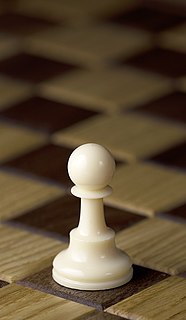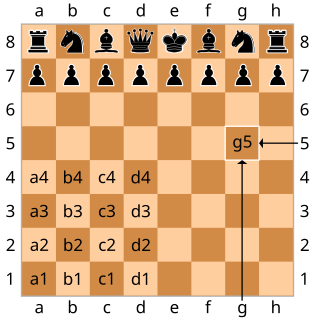Related Research Articles

A chess piece, or chessman, is any of the six different types of movable objects used on a chessboard to play the game of chess.

The pawn (♙,♟) is the most numerous piece in the game of chess and, in most circumstances, also the weakest. It historically represents infantry, or more particularly, armed peasants or pikemen. Each player begins a game with eight pawns, one on each square of the rank immediately in front of the other pieces.

Algebraic notation is the standard method for recording and describing the moves in a game of chess. It is based on a system of coordinates to uniquely identify each square on the chessboard. It is used by most books, magazines, and newspapers. In English-speaking countries, the parallel method of descriptive notation was generally used in chess publications until about 1980. A few players still use descriptive notation, but it is no longer recognized by FIDE, the international chess governing body.

The rules of chess are rules governing the play of the game of chess. While the exact origins of chess are unclear, modern rules first took form during the Middle Ages. The rules continued to be slightly modified until the early 19th century, when they reached essentially their current form. The rules also varied somewhat from place to place. Today, the standard rules are set by FIDE, the international governing body for chess. Slight modifications are made by some national organizations for their own purposes. There are variations of the rules for fast chess, correspondence chess, online chess, and Chess960.
This glossary of chess explains commonly used terms in chess, in alphabetical order. Some of these terms have their own pages, like fork and pin. For a list of unorthodox chess pieces, see Fairy chess piece; for a list of terms specific to chess problems, see Glossary of chess problems; for a list of named opening lines, see List of chess openings; for a list of chess-related games, see List of chess variants.

Pachisi is a cross and circle board game that originated in medieval India which has been described as the "national game of India". It is played on a board shaped like a symmetrical cross. A player's pieces move around the board based upon a throw of six or seven cowrie shells, with the number of shells resting with aperture upwards indicating the number of spaces to move.

Sorry! is a board game that is based on the ancient Indian cross and circle game Pachisi. Players move their three or four pieces around the board, attempting to get all of their pieces "home" before any other player. Originally manufactured by W.H. Storey & Co in England and now by Hasbro, Sorry! is marketed for two to four players, ages 6 and up. The game title comes from the many ways in which a player can negate the progress of another, while issuing an apologetic "Sorry!"

Quoridor is a 2- or 4-player intuitive strategy game designed by Mirko Marchesi and published by Gigamic Games. Quoridor received the Mensa Mind Game award in 1997 and the Game Of The Year in the USA, France, Canada and Belgium.

Escape from Atlantis is a board game that portrays the sinking of Atlantis and the attempts by the population to escape the sinking island. It was originally released in the United States under the title of Survive! and first published in the English language by Parker Brothers in 1982. Survive! was also marketed in Canada, Italy, Spain, and in many other countries.
Yari shogi is a modern variant of shogi ; however, it is not Japanese. It was invented in 1981 by Christian Freeling of the Netherlands. This game accentuates shogi’s intrinsically forward range of direction by giving most of the pieces the ability to move any number of free squares orthogonally forward like a shogi lance. The opposite is true of promoted pieces which can move backward with the same power.
Judkins shogi is a modern variant of shogi, however it is not Japanese. Credit for its invention has been given to Paul Judkins of Norwich, UK, prior to April 1998.
Heian shōgi is a predecessor of modern shogi. Some form of chess almost certainly reached Japan by the 9th century, if not earlier, but the earliest surviving Japanese description of the rules dates from the early 12th century. Unfortunately, this description does not give enough information to actually play the game, but this has not stopped people from attempting to reconstruct this early form of shogi.
Shō shōgi is a 16th-century form of shogi, and the immediate predecessor of the modern game. It was played on a 9×9 board with the same setup as in modern shogi, except that an extra piece stood in front of the king: a 'drunk elephant' that promoted into a prince, which is effectively a second king. According to the Sho Shōgi Zushiki, the drunk elephant was eliminated by the Emperor Go-Nara, and it is assumed that the drop rule was introduced at about the same time, giving rise to shogi as we know it today.

Forbidden Bridge is a board game which simulates being a treasure hunter. Players assume the role of explorers who are after ancient jewels, which are guarded by an angry spirit. Occasionally, the bridge guard will awaken and shake the bridge, which can cause players' pieces to fall off. Players also can get the chance to "steal" another player's jewel. The first player to retrieve two jewels and return them all in their boat wins.

Malefiz is a strategy board game, invented by Werner Schöppner and published by Ravensburger since 1960. It is a non-circular descendant of the ancient Indian board game Pachisi.
Okisaki shogi is a modern variant of shogi. It was developed by Masayuki Nakayachi c. 1996 from suggestions by German chess player Ralph Blockhaus.

The following outline is provided as an overview of and topical guide to chess:
Forbidden Island is a cooperative board game developed by Matt Leacock and published by Gamewright Games in 2010. Two to four players take the roles of different adventurers, moving around a mysterious island, looking for hidden treasures as the island sinks around them. All players win if they find all the hidden treasures and they all make it back to the helicopter and fly away, and they all lose if they cannot.